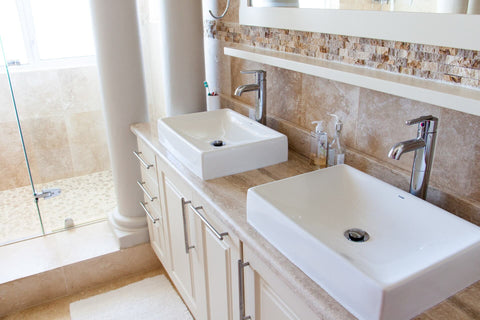
When planning a new tile installation, it’s important to ensure a smooth transition from tile to the wall, ceiling, or other surfaces so that your project looks complete and finished. There is a variety of tile edging options on the market that allow you to remove the exposed edges of tile walls and floors, ensuring proper installation and adding a high-end designer effect to the look. These trim pieces, borders, molding, and accent tiles can elevate your entire design, standing out or highlighting another feature in space by repeating material or finish.
People often use the words trim and molding interchangeably, but there is a difference.
Trim is a more general term and refers to the molding used to frame windows, doors, walls, floors, and ceilings. Although its main purpose is to hide imperfections and cover transitions between surfaces, most people add natural wood, MDF, stone, or vinyl trim to their rooms because it is a bold design statement. It is one of the most important architectural elements in your home. Trim can also be applied in the middle of the wall, such as in the case of a chair rail.
Molding is a type of trim, and it is characterized by enhanced profile, so it is more decorative and elaborate in detail, for example, a crown molding that is installed at the intersections between walls and ceilings.
Tile Edging Options to Consider
There are four main types of tile edge trim that can be used to finish the perimeter of your tiling installations. They include stone trims, porcelain, or ceramic trim tiles, as well as plastic and metal trims, and come in various shapes and sizes.

Speaking about tile edge trim ideas, we should mention bullnose tile, chair rails, cove base, V-caps, flat and pencil liners, and quarter rounds. All these tile edging options allow you to finish your tile for a polished, professional look.
Let’s have a look at different tile trim ideas for walls and floors.
Wall Trim Ideas

Let’s start with wall trim ideas. Molding and trim can turn a plain room into a showpiece, and when it comes to wall moldings ideas, you are limited by only your imagination. Tile trim works well along the middle of a wall, three-quarters down from the ceiling, around windows and doors, or along the edges of architectural features.

A bullnose is the most common trim for walls, as many wall tile lines offer this option to maintain a consistent look. It is a piece of the field tile with one or two rounded edges that are glazed to match the face of the tile. Bullnose tile features the same design and color as a regular tile and can be used installed in the corner of the walls, shower niches, windowsills, and countertops. It’s also a good option to finish shelves, curbs, stair edges, and baseboards that match your tile floor.
Pencil liners can be used on the walls to transition from one tile shape to another. You can also install them to move from tile to the exposed wall.
V-cap edging is another great option to finish practically any tile installation with professional-looking results. You can use then to completely cover perpendicular corners, for example, on windowsills, shower niches, or on shower partition.
Decorative Wall Trim Ideas

Nothing can elevate your space more and take your walls from plain and boring to interesting and special than wall trim molding. It is placed directly on walls and is generally more aesthetic than functional. Still, not all trim styles are created equal.
If you want a trim that is more decorative than a simple rounded bullnose tile, an accent tile can be used to hide the exposed wall tile edges. For example, you can install another linear tile option in a bold color to achieve a finished look. Many individual tile lines come with coordinating accents that will add a modern, sophisticated look to any space.

You can also install a mesh-mounted glass mosaic to cover rough tile edges and increase the visual beauty of the regular tile. You can also choose trendy marble or decorative metal accent tiles to outline your tiled wall, shower, or backsplash.
Speaking about decorative wall trim ideas, we can’t but mention chair rail, which is a good option if you are looking to add a decorative effect to your tile installation. It is a horizontal piece of trim typically 3 feet above the floor. Historically, the function of a chair rail was to protect walls and prevent damage from chairs and other types of furniture. Today, it has become a fashionable design element to create a contrasting look.
Need more chair rail molding ideas? It can be used to cap wall tile, frame stove backsplashes, or other mosaic tile designs. You can also combine it with a lower section of wainscot to give the wall added protection.
Floor Trim Ideas

Here are some floor trim ideas that will help you finish your floor tile design.
Flatliners can be used for lining floor tile and framing statement pieces, such as mosaics.
Schluter edge profiles are used on the floors as transition strips, expansion joints, decorative borders, and for finishing edges. They are perfect for tiles that don’t have a bullnose option and allow you to create a thinner, sleeker edge detail. Some Schluter designs can be used to provide a transition between a tile floor and a floor of a different height.
Cove base can add a finishing touch to any flooring project, creating a seamless transition between the wall and the floor.
Bathroom Molding Ideas

Thinking about adding molding to your bathroom? Use these bathroom molding ideas to take your space to the next level.
Quarter round is a type of trim that is often used in bathroom settings for smoothly scaling an exposed perpendicular edge. You can use them to frame out shower divides, benches, countertops, and window sills.
Cove base tile is especially useful in bathrooms and showers and is visually appealing and functional. It can cover the floor joint and keep moisture from seeping into the walls and floors.
Crown molding is a great option for modern bathrooms that can elevate the space. It can have an effect of perceptually raising the ceiling height, which is always a plus in small spaces.
As you see, there are a lot of beautiful and functional tile edging options that can make your tile project look professional, adding interest to your walls and floors and clearly defining any space.












